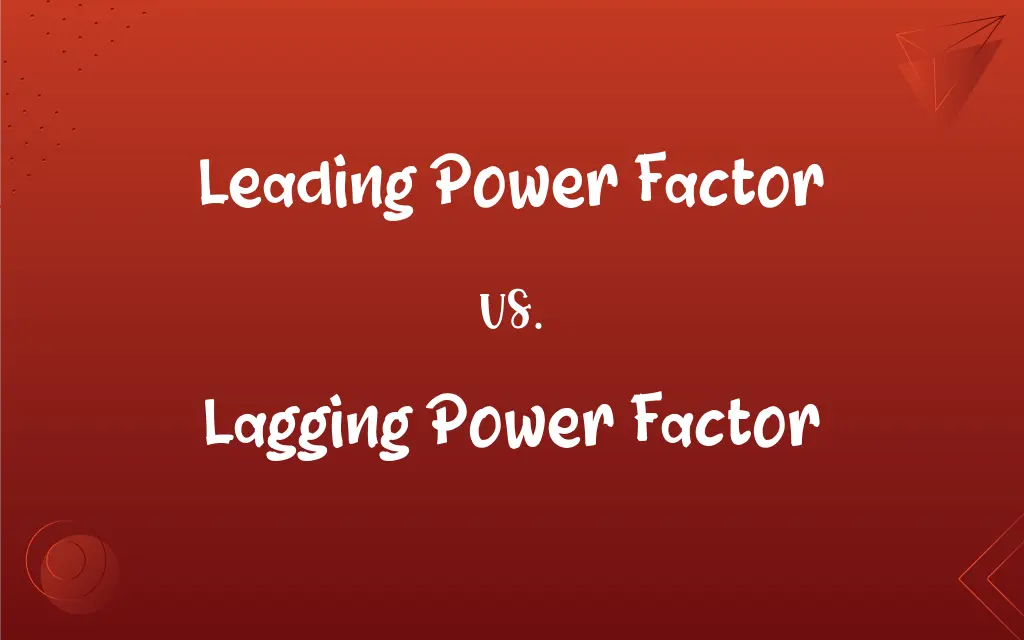Leading Power Factor vs. Lagging Power Factor: What's the Difference?
Edited by Aimie Carlson || By Harlon Moss || Published on February 9, 2024
A leading power factor occurs when current leads voltage in phase, common in capacitive loads, while a lagging power factor happens when current lags voltage, typical in inductive loads.

Key Differences
Leading power factor is associated with capacitive loads where the current waveform leads the voltage waveform. Lagging power factor is typical of inductive loads, such as motors and transformers, where the current lags behind the voltage.
In a leading power factor, the phasor representation shows the current phasor ahead of the voltage phasor. In contrast, a lagging power factor is characterized by the current phasor positioned behind the voltage phasor in a phasor diagram.
Systems with a leading power factor can cause voltage rise issues, particularly in light load conditions. Conversely, a lagging power factor can result in increased losses and reduced efficiency in power systems, necessitating corrective measures like capacitor banks.
To correct a leading power factor, inductive elements like reactors are introduced. For correcting a lagging power factor, capacitive devices, such as capacitors, are utilized to bring the power factor closer to unity.
Leading power factor is less common in general power systems compared to lagging power factor, often occurring in systems with large capacitor banks. Lagging power factor is prevalent in industrial settings with heavy machinery and inductive devices.
ADVERTISEMENT
Comparison Chart
Associated Load
Capacitive
Inductive
Phasor Relationship
Current leads voltage
Current lags voltage
System Effects
Can cause voltage rise
Leads to increased losses and reduced efficiency
Correction Methods
Requires inductive elements for correction
Corrected using capacitive devices
Common Occurrence
Less common, in systems with large capacitors
Common in industrial settings with heavy machinery
ADVERTISEMENT
Leading Power Factor and Lagging Power Factor Definitions
Leading Power Factor
Leading power factor occurs in capacitive loads where current leads voltage.
The wind farm's generators exhibit a leading power factor at certain wind speeds.
Lagging Power Factor
Corrected using capacitive devices like capacitor banks.
To improve efficiency, we installed capacitor banks to correct the lagging power factor.
Leading Power Factor
It is less common and can occur in systems with large capacitor banks.
Large capacitor banks in the data center created a leading power factor scenario.
Lagging Power Factor
Common in industrial settings with machinery and inductive devices.
In most industrial plants, inductive loads result in a predominantly lagging power factor.
Leading Power Factor
Corrected by introducing inductive elements.
To correct the leading power factor, we added inductive reactors to the circuit.
Lagging Power Factor
Causes increased losses and reduced efficiency in power systems.
The lagging power factor of the HVAC system leads to higher energy costs.
Leading Power Factor
It is indicated by the current phasor leading the voltage phasor.
In the phasor diagram, the current phasor is ahead, indicating a leading power factor.
Lagging Power Factor
Lagging power factor occurs in inductive loads where current lags voltage.
The factory's motors operate with a lagging power factor.
Leading Power Factor
Leading power factor can cause voltage rise in electrical systems.
The utility company noted a voltage rise due to the leading power factor in the local grid.
Lagging Power Factor
Characterized by the current phasor lagging behind the voltage phasor.
The current's delay behind the voltage in the phasor diagram shows a lagging power factor.
FAQs
What is a leading power factor?
It's when current leads voltage in phase, typically in capacitive loads.
How is leading power factor corrected?
It's corrected by adding inductive elements to the system.
What is a lagging power factor?
It's when current lags behind voltage in phase, common in inductive loads.
What are the effects of a lagging power factor?
It leads to increased energy losses and reduced efficiency.
How is lagging power factor corrected?
It's corrected with capacitive devices, such as capacitor banks.
Why is power factor correction important?
Correction is important for improving efficiency and reducing losses in power systems.
What devices commonly have a leading power factor?
Devices with large capacitor banks, like certain electronic equipment.
What are the effects of a leading power factor?
It can cause voltage rise issues in electrical systems.
What causes a leading power factor?
A leading power factor is caused by capacitive elements in the circuit.
What causes a lagging power factor?
A lagging power factor is caused by inductive elements like motors and transformers.
What is power factor in simple terms?
Power factor measures the efficiency of power use, defined by the phase difference between voltage and current.
How does leading power factor affect utility billing?
Utilities may charge penalties for leading power factor due to its impact on the grid.
Is a lagging power factor desirable?
Generally, it's undesirable due to efficiency losses and increased utility costs.
What equipment typically has a lagging power factor?
Inductive equipment like motors, transformers, and inductors.
Are there penalties for lagging power factor?
Yes, many utilities impose penalties for lagging power factor due to the extra costs it incurs.
Can leading power factor be beneficial?
In certain cases, it can help counteract a lagging power factor in the system.
Do residential homes need power factor correction?
Generally, residential homes have less need for correction compared to industrial settings.
Is leading power factor good or bad?
It can be problematic, causing voltage stability issues in the power grid.
About Author
Written by
Harlon MossHarlon is a seasoned quality moderator and accomplished content writer for Difference Wiki. An alumnus of the prestigious University of California, he earned his degree in Computer Science. Leveraging his academic background, Harlon brings a meticulous and informed perspective to his work, ensuring content accuracy and excellence.
Edited by
Aimie CarlsonAimie Carlson, holding a master's degree in English literature, is a fervent English language enthusiast. She lends her writing talents to Difference Wiki, a prominent website that specializes in comparisons, offering readers insightful analyses that both captivate and inform.







































































